Top Insecticides for Carpenter Bee Control
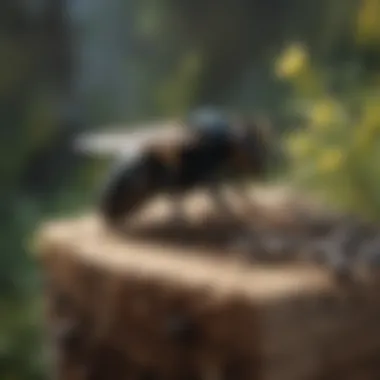
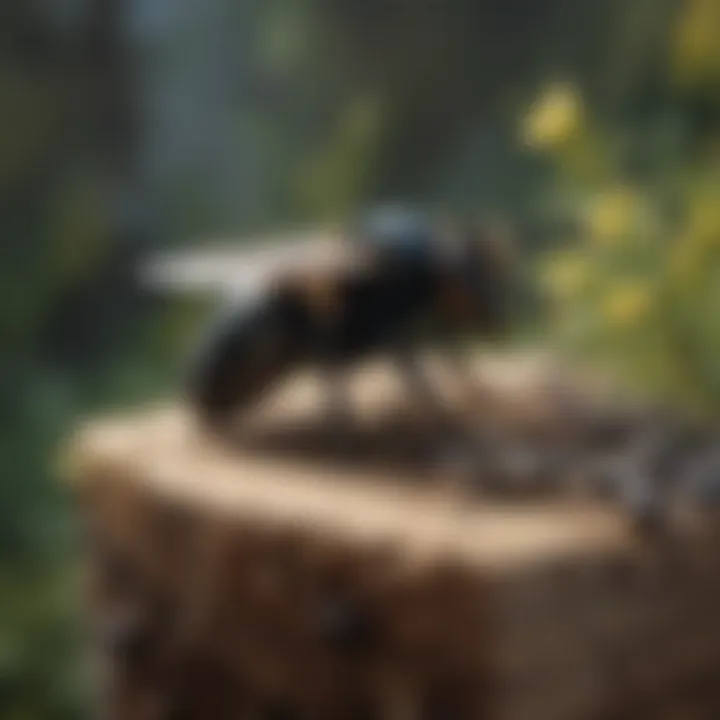
Intro
Carpenter bees are often seen buzzing around our homes, and while they may look harmless, their nesting habits can spell trouble for wooden structures. Their ability to excavate tunnels in wood not only weakens beams but can lead to costly repairs. As homeowners or gardening enthusiasts, understanding how to manage these bees is crucial. This article dives into effective ways to deal with carpenter bees, focusing on various insecticides that can help in controlling their populations. We’ll also take a closer look at their biology and behavior, the impact they have on structures, and highlight eco-friendly options that can be employed for effective pest management.
To put it simply, finding the right strategy for dealing with these bees ensures your wooden structures remain safe and sound.
Understanding Carpenter Bees
Before we dive into insecticides, it's worthwhile to understand who we're dealing with. Carpenter bees, unlike honeybees, often bore into wood to create a nesting site. They are generally solitary insects, and while they may not sting readily, their presence and the damage they cause can certainly be a pain.
Behavior and Characteristics
These bees display a behavior reminiscent of certain types of wasps, often hovering around wooden areas, trying to find suitable places to nest. Their black and yellow coloring can sometimes cause confusion, leading people to mistake them for other species. Each female can create up to a dozen tunnels, leading to extensive damage over time if not addressed promptly.
The Importance of Treatment
Ignoring a carpenter bee infestation is akin to leaving a slow leak in a roof—it may not seem urgent at first, but it can lead to extensive damage over time. The tunnels they create can serve as entry points for other pests, which compounds the issue. Treatment is crucial not only for preserving the structural integrity of your home but also for maintaining a safe environment for your family.
Factors Influencing Choice of Insecticide
When it comes to choosing insecticides for carpenter bees, several factors come into play:
- Efficacy: Does it effectively eliminate the bees?
- Safety: How safe is it for humans and pets?
- Environmental Impact: Will it harm beneficial insects or plants?
- Ease of Use: How straightforward is the application process?
Design Inspiration
Trending Styles
Though it might seem like an odd segue, incorporating pest management into property design can pivot toward a more sustainable approach. Modern homeowners often prefer a natural aesthetic, one that blends seamlessly with the environment while deterring pests like carpenter bees.
Integrating materials that are less susceptible to infestation, such as composite decking or synthetic siding, can effectively reduce the risk without sacrificing style. Homes designed with wood out of reach and utilizing metal or other durable materials often see fewer carpenter bee invasions.
Color Palettes
Color also plays a key role. Using lighter shades for exterior paints can often distract these bees from their favorite targets. Keeping wooden elements painted not only enhances the look but also protects them from these pests. Utilization of non-toxic colors can be appealing for eco-conscious homeowners seeking to keep design in line with their values while also considering pest management.
Practical Tips
Maintenance & Care
Sustaining your property requires diligence. Regular maintenance checks of wood structures can help catch any signs of tunneling early. If you notice loose paint or small holes, it might be worth addressing before a full infestation occurs.
Some methods for maintaining wooden areas include:
- Regular Inspections: Check wood surfaces yearly or seasonally.
- Paint and Seal: A fresh coat of non-toxic paint can serve as a deterrent.
- Repair Damage Promptly: Even minor damage should be addressed to prevent nesting.
Budgeting & Planning
In terms of budgeting for pest control, bear in mind that prevention is often cheaper than treatment. Allocating some funds toward preventative measures can save you a bundle in the long run. Keep these points in mind:
- Initial Treatments: Budget for insecticides or pest control services.
- Ongoing Maintenance: Set aside funds for regular inspections and treatments.
- Educational Resources: Investing in information can pay off when costs arise from damage.
"An ounce of prevention is worth a pound of cure."
This old adage couldn’t ring truer when it comes to managing carpenter bees.
End
As we seek to balance our living spaces with the natural world, understanding our insect neighbors becomes essential. The right insecticide, comprehensive maintenance, and thoughtful design can create a harmonious environment that keeps both homes and ecology in check.
Foreword to Carpenter Bees
Understanding carpenter bees is crucial for homeowners and gardening aficionados alike. These industrious insects, while often mistaken for bumblebees due to their similar appearance, have a penchant for munching on wood, causing structural damage if left unchecked. By comprehending their behavior and the potential harm they inflict on our property, we can implement effective measures to mitigate their impact. Recognizing early signs of infestation and knowing when to act can save not only time but also significant repair costs down the line.
Understanding Carpenter Bee Behavior
Carpenter bees, belonging to the genus Xylocopa, are known for their solitary nature, unlike many other bee species that thrive in colonies. This particularity leads them to excavate holes in wood to create nests—these borings can be rather sizeable, resembling the size of a dime or larger.
Typically, the female carpenter bee, with her stout abdomen and shiny, black body, takes the lead in building the nest. She's not one to shy away from human activity; in fact, you'll often find her buzzing around porches, decks, or even wooden garden furniture. Males, characterized by their fuzzy yellow markings, are recognized by their less aggressive demeanor. It’s the females that possess the sting, but they are generally not keen on using it unless provoked.
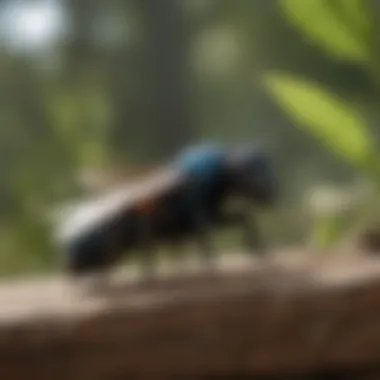
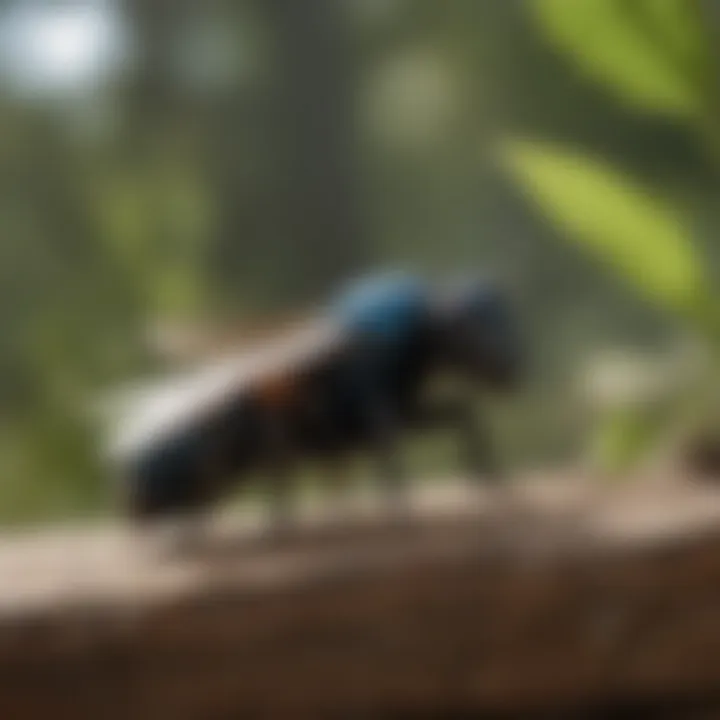
Their life cycle is nothing short of fascinating. The females mate, lay eggs, and seal the nested chambers with pollen and nectar—essentially prepping for the next generation's arrival before sealing themselves into their wooden sanctuary. As these bees emerge in spring, they’ll be searching for food sources, and it’s during this time that they might start their woodwork, literally. Understanding this seasonal behavior allows homeowners to be proactive.
The Impact of Carpenter Bees on Wooden Structures
While their presence might go unnoticed at first, carpenter bees can be quite the wrecking balls when it comes to wooden structures. Wood, particularly untreated or weathered varieties, tends to be their favorite buffet. Their nesting habits lead to tunnels that, if left unaddressed, can compromise the integrity of beams, decks, and even siding.
- Extent of Damage: What starts as a small hole can progressively become a serious concern. Over time, these tunnels can weaken the structure, leading to costly repairs.
- Secondary Issues: It’s worth noting that once carpenter bees bore into wood, they're not alone. Their tunnels can become habitats for mold and other pests, creating a ripple effect of issues for the homeowner.
- Preventive Measures: Regular inspection and maintenance are vital. Look out for signs such as sawdust piles under potential nesting sites, which can signal an infestation. Frequent checks post-winter season can ensure any emerging bees are dealt with before they get the chance to create a full-blown colony in your home.
With proper understanding and awareness of carpenter bee behavior and their impact on wooden structures, homeowners can shift from reactive measures to proactive strategies. This knowledge not just benefits property preservation but also encourages responsible pest management in line with ecological balance.
Identifying Carpenter Bees
Identifying carpenter bees accurately is crucial for any homeowner. These bees, different from their more socially known cousins, can wreak havoc on wooden structures and gardens if not addressed timely. Understanding their traits and behavior helps not only in pest control but also in taking preventive measures.
Differences Between Carpenter Bees and Bumblebees
Carpenter bees and bumblebees might seem similar at first glance, but a closer look will reveal distinct differences.
- Physical Appearance: Carpenter bees have shiny abdomens and are typically more streamlined when compared to the fuzzy, hairy bodies of bumblebees. The lack of hair gives them a more polished appearance.
- Behavior: While bumblebees are social and live in colonies, carpenter bees are solitary. They tend to be more aggressive if threatened but are less likely to sting since they usually don’t protect a nest.
- Nesting Habits: Carpenter bees create holes in wood to lay their eggs, whereas bumblebees build nests in the ground or existing cavities. If you notice round holes in your wooden deck or siding, chances are it's the work of carpenter bees.
Identifying the right species is essential not only for effective control but also for understanding the ecological role that these bees play in your garden. Be mindful of their looks and habits before taking action.
Signs of Carpenter Bee Infestation
Recognizing the signs of a carpenter bee infestation can save your wooden structures from significant damage. Here are the key indicators:
- Visible Holes: Look for perfectly round holes, about 1/2 inch in diameter, which are the entrance to nesting tunnels. These holes may be found on eaves, decks, and wooden furniture.
- Wood Dust: Sawdust-like material around the entrance point can indicate an infestation. This debris is the result of the bees tunneling into the wood.
- Watch for Bees: During the warmer months, observing carpenter bees hovering around their nest entrances offers direct evidence of their presence. Look for the males who patrol the area, often exhibiting territorial behavior.
- Structural Damage: Over time, if left untreated, these bees can cause extensive damage. If you notice sagging, loose wood or unusual sounds coming from your wooden structures, that could be a red flag.
Identifying carpenter bees accurately can lead to prompt action, minimizing damage and ensuring the structural integrity of your home.
In summary, recognizing the traits and behaviors of carpenter bees allows you to differentiate them from bumblebees. Furthermore, being attentive to signs of infestation can guide you in taking necessary measures to protect your property.
Overview of Carpenter Bee Insecticides
Carpenter bees can swiftly become a nuisance for homeowners, particularly when they decide to make a meal out of wood. Understanding the available insecticides is crucial. This section delves into the significance of the choices you have for dealing with these pestiferous bugs. Insecticides, whether synthetic or natural, help mitigate damage to wooden structures, as well as protect the aesthetics and integrity of your home. When you arm yourself with the right knowledge, it’s easier to make informed decisions that consider effective pest control alongside environmental and human safety.
Insecticides are your frontline defense against carpenter bees, acting as a deterrent and eradicating any existing infestations. The right product choice not only aids in immediate pest management, but also plays a role in long-term prevention strategies. Being aware of factors like the chemical composition, application methods, and specific targeting of the pests can help ensure that you address the problem efficiently without unwanted side effects.
Synthetic Insecticides
Synthetic insecticides tend to be popular choices for controlling carpenter bee populations. Products like pyrethroids and neonicotinoids are well-known options. They work in different ways: some disrupt the nervous system while others affect the insect’s ability to function normally.
- Effectiveness: Many synthetic insecticides are designed to act quickly, offering immediate relief from carpenter bee invasions. However, their speed can sometimes come at a cost. Some may have detrimental effects on beneficial insects and the surrounding ecosystem, if not applied carefully.
- Application Methods: These products can generally be applied via sprays, dusts, or granules. Using a targeted approach minimizes exposure to non-target species. Often you simply need to follow the instructions doled out on the label.
An important factor to consider is the duration of effectiveness and whether the insecticides are residual—lasting long after application. This trait helps in reducing repeat infestations. For instance, the formula of the potent Bifen IT can provide residual protection against carpenter bees, acting as a barrier even after the initial spray.
Natural Insecticides
Natural insecticides often promise a more eco-friendly route when managing carpenter bees. They’re a boon for those who are cautious about using harsh chemicals in their environment. First on the list is neem oil, derived from the seeds of the neem tree. It’s potent and can repel and disrupt the life cycle of carpenter bees. Other natural options include insecticidal soaps and diatomaceous earth.
- Less Toxicity: The primary advantage of these insecticides is their lower impact on non-target species. Many natural insecticides have a shorter residual effect, which could be a benefit when considering long-term ecological implications.
- Application Techniques: Commonly, natural insecticides can be sprayed directly on infested areas. They’re generally considered safer to use around pets and humans. Just remember, the effectiveness can be slower than synthetic choices.
It's vital to ensure thorough coverage for achieving the desired outcome. Sometimes, combining different methods could yield better results yet, it requires a careful balance.
A biodegradable answer might not just save your wooden structures, but also keep the ecological balance intact in your garden.
In summary, understanding the range of insecticides available sets the stage for effective carpenter bee management. When you choose between synthetic and natural insecticides, you’re not only addressing the immediate problem but also considering the broader environmental context.
Evaluating Performance of Insecticides
When it comes to dealing with carpenter bees, not all insecticides are created equal. Evaluating the performance of these substances is not just about comparing brands or formulas; it involves understanding a complex mesh of factors that affect efficacy. Homeowners need to be certain that the insecticide they choose can deliver on its promises to protect their wooden structures while ensuring the safety of people and pets around them.
The effectiveness of insecticides can vary depending on the method of application, the location of the infestation, and the timing of treatment. Furthermore, examining the chemical composition of these products helps in determining their environmental impact and potential health risks. With all this in mind, it becomes crystal clear why a detailed analysis is a vital part of managing carpenter bee populations. It's not just about managing a pest; it's about securing your home and making sure that your choices have the least harmful ripple effect on the environment.
Effectiveness of Various Insecticide Brands
When assessing various insecticide brands, homeowners encounter a range of choices from well-known names like Ortho and Spectracide to more niche products specialized for outdoor use. Each brand comes with its own set of active ingredients, application methods, and effectiveness claims.
- Ortho Carpenter Bee Killer: Known for its targeted spray and instant knockdown effect, this product utilizes a mix of pyrethroids, which have shown to be quite effective against adult carpenter bees.
- Spectracide Triazicide: This granular insecticide is useful for creating a barrier around infested areas, offering a long-lasting solution with its residual action.
- EcoSMART Organic Insect Killer: For those leaning towards eco-friendly options, this plant-based insecticide boasts about being non-toxic while still effectively managing carpenter bees.


With each product, looking at user reviews and professional recommendations can provide deeper insights into performance. A pest management plan should also consider the local environment—what works wonders in one state might fall short in another due to differing ecosystems and bee behavior.
Application Techniques for Maximum Efficacy
Applying insecticides properly is half the battle. Homeowners should not only follow the directions on the label but also consider a few additional strategies to enhance effectiveness.
- Target Entry Points: Carpenter bees typically create holes in wood—foundationally, focusing applications directly on these entry points can lead to greater success.
- Timing Matters: Applying insecticides during peak activity times, usually in the early morning or late afternoon when bees are most likely to be in the nest, enhances the likelihood of effective treatment.
- Weather Conditions: Windy or rainy conditions can dilute the application or disperse the insecticide. Plan to treat on a calm day.
It's worth noting that any application should be done with careful observation to prevent overspray, thus safeguarding beneficial insects in your garden.
"A well-applied insecticide isn’t just a spray; it’s a protective barrier to your home’s structure."
Safety Considerations When Using Insecticides
When it comes to controlling carpenter bees, ensuring the safety of yourself, your loved ones, and the environment is paramount. Understanding the potential risks associated with using insecticides will empower you to make informed decisions. It’s not just about eliminating a pest; it’s about balancing effectiveness with safety. This section will delve into essential safety measures and the broader environmental implications that accompany the use of these chemical agents.
Personal Safety Measures
Using insecticides requires thoughtful preparation. First and foremost, consider wearing protective gear. This means gloves, goggles, and sometimes a mask to avoid inhaling any harmful chemicals. It might feel a bit over the top, but trust me, a little precaution goes a long way.
Moreover, choosing the right time for application can make a big difference. For instance, applying insecticide in the early morning or late afternoon, when temperatures are cooler, can minimize the risk of chemical drift. Here are a few tips:
- Read labels: Always refer to the manufacturer's instructions. Each product offers guidance on dosages and safe handling.
- Avoid windy days: Trying to spray during a gusty day is like trying to nail jelly to a wall; it just won’t work as intended.
- Clear the area: Make sure to keep children and pets away from the vicinity during application. Think of it as setting up a safety perimeter.
Keeping your application site clean and organized can prevent spills or mishandling of the insecticides. In case of an accident, knowing the first aid procedures for exposure can be lifesaving. Always have an emergency contact number handy, especially if you're trying a new product for the first time.
Environmental Impact of Insecticides
The impact of insecticides on the environment cannot be brushed aside. Pesticides, while effective, can possess adverse effects that reach beyond the intended target. From bees to butterflies, the collateral damage could be significant. Understanding this can shape your approach to pest management.
When selecting insecticides, you should consider the class of chemicals used. Some products boast being less harmful due to their composition, but they might still affect non-target species. Additionally, consider using integrated pest management strategies where you combine chemicals with natural deterrents, reducing overall chemical use.
- Bioaccumulation risk: Some chemicals can accumulate in the food chain, making it vital to assess the long-term effects on local wildlife.
- Water runoff: Rain can wash residual chemicals into nearby streams and ponds, potentially harming aquatic life.
- Soil health: Certain insecticides can disrupt the natural soil ecosystem, affecting beneficial organisms.
"We must remember that nature is a delicate balance; pesticides can tip the scales in unexpected ways."
Choosing eco-friendly options, or at least products marked as environmentally safe, fosters a healthier biotope. Always look for organic certifications or minimal impact claims. Their presence can make your choices lean towards sustainability.
Integrated Pest Management Strategies
In the quest to control carpenter bee populations, Integrated Pest Management (IPM) strategies stand as a beacon of holistic approach. The relevance of this topic within our discussion cannot be overstated. Rather than resorting to a one-size-fits-all method, IPM offers a multi-faceted roadmap that prioritizes not only effective bee control but also environmental stewardship. The pivotal elements include monitoring bee activity, assessing infestation levels, and implementing a series of both chemical and non-chemical controls to minimize harm to beneficial insects and the broader ecosystem.
Utilizing Physical Barriers
One of the most effective and immediate methods under the IPM framework is the deployment of physical barriers. These barriers can range from simple practices to more elaborate structures. Consider the following options:
- Wood Treatment: Applying a weather-resistant sealant to wooden structures can prevent carpenter bees from boring into them. When the wood is less inviting, bees will be less likely to set up shop.
- Bee Screens: Installing fine mesh screens over vents and gaps in eaves can block access to potential nesting sites, restricting the bees from infiltrating those areas.
- Exclusion Materials: Using caulking and expanding foam to seal cracks and crevices in wood can effectively thwart these wood-boring pests.
These strategies not only protect your wooden structures but also discourage bees from returning to the same location year after year. It’s like telling a houseguest, "This place is full. Go find a hotel!"
Encouraging Natural Predators
Another way to maintain a balance is to encourage natural predators, which play an essential role in managing carpenter bee populations. By fostering an environment that supports these beneficial species, homeowners can organically reduce pest numbers without excessive reliance on synthetic chemicals. Here are some suggestions:
- Creating Habitats: Planting a diverse array of flowering plants can attract species such as ladybugs and lacewings, which feed on various pests in your garden, including juvenile forms of bees.
- Nesting Opportunities for Predators: Using bee hotels or other shelters that are designed for predatory insects can help these beneficial species thrive and reduce carpenter bee populations. This creates a habitat where pollinators and natural controllers coexist harmoniously.
- Avoiding Broad-Spectrum Insecticides: While it can be tempting to spray every culinary herb or blooming flower with synthetic treatments, doing so harms not just the target pest but also beneficial insects. Minimizing these chemical applications can result in a more vibrant ecosystem.
"An ounce of prevention is worth a pound of cure."
Implementing strategies to encourage natural predators can deliver long-term control of carpenter bee populations while fostering a more biodiverse landscape.
These IPM strategies highlight the importance of an informed, adaptable approach to pest management. Homeowners can protect their properties, support ecological balance, and actively engage in practices that lead to sustainable pest management.
Alternative Methods for Carpenter Bee Control
Carpenter bees can be quite the nuisance when it comes to wooden structures, often causing more damage than meets the eye. While traditional insecticides are certainly effective, exploring alternative methods can provide homeowners with additional, eco-friendly options to keep these pests at bay. In this section, we will delve into specific elements, benefits, and considerations regarding alternative methods to control carpenter bees. This not only helps in managing the immediate problem but also fosters a more sustainable living environment.
Homemade Insecticide Recipes
Creating your own insecticide can be a straightforward process, and many recipes utilize common household items. Here are a couple of simple homemade insecticides that you can try:
- Soap and Water Mixture: Just mix two tablespoons of any liquid dish soap with a quart of water. Fill a spray bottle and give the carpenter bees a spritz directly; they won't like it one bit. The soap clogs their breathing pores, ultimately leading to their demise.
- Peppermint Oil Solution: Combine 10 drops of peppermint essential oil with a cup of water and a teaspoon of dish soap. This mix not only repels carpenter bees but also smells fresh! Spray it on areas where you've identified activity.
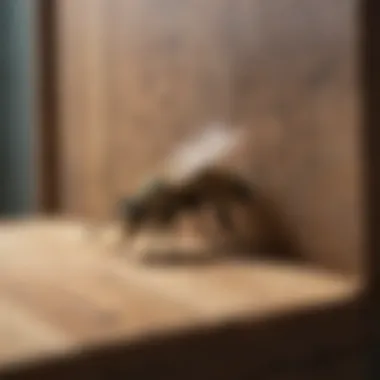

Tip: Always test your homemade insecticides on a small area first to ensure there’s no damage to the surface.
Using homemade insecticides has its own share of advantages. They are typically more affordable than commercial products, minimize chemical exposure to your environment, and can be safely used around pets and children when applied thoughtfully.
Non-Chemical Solutions
For those who prefer to avoid chemicals altogether, there are several non-chemical solutions that can effectively deter carpenter bees without harming the environment:
- Physical Barriers: Sealing up holes and reinforcing wood can prevent carpenter bees from nesting. After proper inspection, fill any existing holes with wood putty or caulking, making it less appealing for these pests.
- Plant Repellents: Certain plants naturally repel carpenter bees, such as citronella and eucalyptus. By incorporating these into your garden, you not only beautify the space but create a natural deterrent.
- Ultrasonic Repellents: These devices emit a frequency that is unpleasant for insects but inaudible to humans. It can create a bee-free zone in your yard, offering a high-tech solution to pest control.
Adopting non-chemical methods provides peace of mind regarding safety and health. These solutions typically also foster a balanced ecosystem in your garden, maintaining the presence of beneficial insects while discouraging nuisances like carpenter bees.
By considering these alternative methods for carpenter bee control, homeowners can create a multi-faceted pest management system. This approach not only ensures the safety of your wooden structures but also promotes a healthier environment.
Long-Term Prevention Techniques
Implementing long-term prevention techniques to manage carpenter bees is essential for maintaining the integrity of wooden structures and ensuring the overall health of the environment. Unlike temporary solutions that often just tackle the symptoms, effective long-term strategies address the root causes of bee infestations. These methods not only reduce the need for intensive pesticide application but also promote a harmonious cohabitation with nature.
Sealing Entry Points
One of the most critical steps in preventing carpenter bee infestations is sealing entry points in wooden structures. Carpenter bees are notorious for drilling holes into untreated wood, making them especially fond of eaves, decks, and fence posts. By sealing these vulnerable spots, homeowners can significantly reduce the chances of bees being able to establish nests.
- Use High-Quality Sealants: Employ durable weatherproof sealants to cover any existing holes or cracks. Not only do they block potential entrances but they also help in maintaining the integrity of the wood over time.
- Prioritize Maintenance: Inspect your property for any signs of wood rot or damage. Repair any weak spots, as they can attract carpenter bees looking for a nesting place.
- Consider Paint or Stain: A fresh coat of paint or stain can also act as a deterrent. Bees tend to favor untreated wood, so adding a protective finish can help keep them at bay.
Sealing entry points not only protects your structures but also maintains the aesthetic appeal of your property.
Regular Inspections and Maintenance
Routine inspections and maintenance can go a long way in preventing carpenter bee issues. By being vigilant, homeowners can catch potential infestations before they turn into full-blown issues.
- Schedule Seasonal Checks: Make it a habit to inspect your wooden structures, particularly in the spring when carpenter bees are most active. Look for new holes or sawdust around existing holes, both of which can indicate nesting activity.
- Trim Overhanging Branches: If tree branches or other vegetation hang over your home, it can provide easy access for carpenter bees. Regularly prune back overhanging elements to reduce their chances of landing on your wooden components.
- Educate Yourself on Signs of Infestation: Familiarize yourself with the typical signs of carpenter bee problems. For instance, if you notice a consistent presence of bees hovering around a particular area, it’s time to investigate further.
By establishing a routine of inspections and focusing on sealing vulnerable spots, homeowners can create a long-term barrier against the invasions of carpenter bees while helping maintain the beauty and functionality of their outdoor spaces.
Case Studies of Effective Carpenter Bee Management
Understanding how others have tackled carpenter bee problems can offer invaluable insights. Case studies of effective management strategies not only showcase practical applications but also provide real-world data on the outcomes of various approaches. Homeowners often feel overwhelmed when faced with pest management, particularly with insects like carpenter bees that can cause structural damage. This section highlights the importance of shared experiences, revealing both the successes and challenges faced by different individuals and communities.
Successful Insecticide Applications
In various neighborhoods, homeowners have documented their experiences with different insecticides aimed at controlling carpenter bee populations. For instance, a homeowner in the Midwest applied Spectracide Bug Stop around the eaves of their house, reporting significant reduction in bee activity within just a few days. The clear guidance on application methods, including using a high-pressure sprayer to soak the wood surfaces, was an integral part of their success.
Another compelling case involved a gardening enthusiast living near wooded areas. This individual discovered that a combination of Bayer Advanced Complete Insect Killer and timely inspections proved effective. They noticed that applying the insecticide early in the spring, before the bees became active, greatly reduced the likelihood of infestations by preventing the bees from establishing nests.
Moreover, case studies involving the use of natural insecticides, like essential oil sprays, have gained traction. A family in California experimented with a mixture of peppermint oil and water. Not only did it repel bees, but they also reported that it had a pleasant scent, making it a delightful alternative to harsh chemicals.
Community Approaches to Bee Management
Community strategies represent another layer of effective carpenter bee management. In a small town, residents banded together to create a local pest control program focused on education and shared resources. They held workshops, inviting local experts to discuss integrated pest management techniques focused on prevention. They promoted the use of physical barriers, such as wooden screens and painting untreated wood surfaces to reduce nesting.
Another interesting example comes from a conservation initiative in the Pacific Northwest, where communities took a cooperative stance against carpenter bees. They raised awareness about the bees’ role in pollination, which helped foster an understanding that not all interactions with these insects should lead to extermination. Instead of simply eradicating carpenter bees, they opted for a more balanced approach, advocating for habitat management that keeps bee populations in check while safeguarding their ecological contributions.
Sharing these real-life examples highlights how effective carpenter bee management can be a multifaceted effort. Solutions are often most powerful when they emerge from the community, combining individual experiences, innovative applications, and cooperative strategies that benefit everyone.
The End
Understanding the dynamics of carpenter bee management is paramount for homeowners and gardening enthusiasts alike. These bees may look harmless, but their nesting habits can lead to significant structural issues in wooden structures, which can be expensive to repair. The insights provided in this article outline not only the various insecticide options available but also emphasize the significance of integrated pest management strategies that balance efficacy with ecological responsibility.
Summarizing Key Points
Throughout this guide, we have explored several crucial aspects of carpenter bee control:
- Behavior and Impact: Carpenter bees, being solitary insects, create nests that can compromise the integrity of wooden structures. Recognizing their behavior is essential in mitigating their presence.
- Insecticide Options: We detailed various insecticide formulations including synthetic and natural options. Each type has its pros and cons, making it important for homeowners to select a product that aligns with their values and needs.
- Application Techniques: Proper application methods can make a significant difference. Following the manufacturer's guidelines ensures that products work effectively while minimizing the risk of harm to non-target species.
- Safety and Environmental Considerations: Emphasizing safety measures is non-negotiable. Homeowners must prioritize personal safety and consider the ecological impact of the insecticides they choose.
- Long-term Prevention: Simple tasks such as sealing entry points and maintaining regular inspections can significantly reduce the likelihood of infestations.
Future Perspectives on Carpenter Bee Control
Looking ahead, awareness and adaptability will be the foundation for successful carpenter bee management. Future strategies might involve:
- Advancements in Eco-friendly Solutions: As the public becomes more conscious about the environment, we can expect a shift toward more biological insecticides and natural deterrents that do less harm to beneficial insects.
- Research on Bee Behavior: More studies be needed to understand the intricacies of carpenter bee behavior and their role in the ecosystem, leading to better preventive measures and control methods.
- Community Engagement: Increased community involvement in pest management strategies could provide a wealth of knowledge and resources. Collaborating with local extension services or gardening clubs can offer continued learning opportunities.
- Legislation on Pesticides: As regulations on chemical insecticides continue to tighten, there may be more emphasis on developing safer alternatives and fostering practices that support pollinator health.
In summary, it is not just about understanding how to control carpenter bees; it's also about fostering a harmonious relationship between the needs of humans and the natural world. With the right mindset and tools, homeowners can protect their properties while preserving the vital roles that all bees play in our environment.
"Bees are a fundamental part of our ecosystem, and managing their populations responsibly can lead to healthier environments for us all."
By implementing the strategies discussed and remaining informed, homeowners can navigate the challenges posed by carpenter bees effectively.















